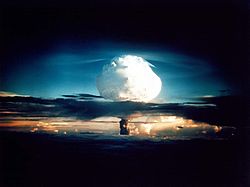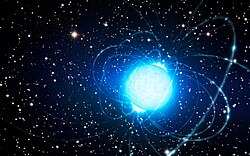High Energy Transient Explorer 1 (HETE-1) was a NASA astronomical satellite with international participation (mainly Japan and France). The concept of...
8 KB (821 words) - 23:47, 31 March 2023
HETE 2 (redirect from High Energy Transient Explorer 2)
High Energy Transient Explorer 2 (HETE-2; also known as Explorer 79) was a NASA astronomical satellite with international participation (mainly Japan and...
18 KB (2,230 words) - 15:21, 17 November 2023
HETE may refer to: High Energy Transient Explorer Hydroxyeicosatetraenoic acids: 5-Hydroxyeicosatetraenoic acid 8-hydroxyeicosatetraenoic acid (8-HETE)...
543 bytes (92 words) - 20:34, 9 November 2022
from the original on 2016-03-04. Retrieved 2008-02-27. "The High Energy Transient Explorer (HETE-2)". Massachusetts Institute of Technology. 28 March 2007...
129 KB (5,530 words) - 13:56, 26 May 2025
NASA HEASARC. Retrieved 2007-12-05. PTInews.com[permanent dead link] HETE-2: High Energy Transient Explorer BATSE: Burst and Transient Source Explorer...
20 KB (2,602 words) - 06:16, 28 May 2025
resulted in the loss of gamma-burst identifying satellite HETE (High Energy Transient Explorer). The Pegasus XL, introduced in 1994 has lengthened stages to...
50 KB (3,010 words) - 01:13, 19 April 2025
HETE-2: High Energy Transient Explorer (Wiki entry) INTEGRAL: INTErnational Gamma-Ray Astrophysics Laboratory (Wiki entry) BATSE: Burst and Transient Source...
115 KB (12,616 words) - 05:02, 30 May 2025
likely to play a key role in the move to exascale computing. The High Energy Transient Explorer 2 (HETE-2) spacecraft used 4× T805 transputers and 8× DSP56001...
45 KB (5,838 words) - 13:34, 12 May 2025
began discussing plans for a new GRB research satellite, the High Energy Transient Explorer (HETE). Although many satellites were already providing data...
30 KB (4,100 words) - 12:03, 30 April 2025
on 13 August 2002 02:44 UTC by multiple instruments on the High Energy Transient Explorer. The burst lasted approximately 125 seconds. The initial position...
5 KB (521 words) - 16:23, 21 May 2025
produce black holes. Woosley is also co-investigator on the High Energy Transient Explorer-2, a satellite dedicated to the study of gamma-ray bursts, launched...
4 KB (347 words) - 16:26, 9 January 2025
Spectrometer (XGRS) on NEAR Shoemaker, the High Energy Transient Explorer (WMM and SXC), the Rossi X-ray Timing Explorer (PCA and ASM) and Ulysses. "GCN - Missions...
7 KB (779 words) - 19:44, 26 May 2025
scientist. In Los Alamos he has worked in: Gamma-ray bursts: High Energy Transient Explorer and HETE-2 satellites, the Raptor telescope suite, the Swift...
11 KB (892 words) - 03:08, 29 March 2025
observation of their fading remnants in distant galaxies. The High Energy Transient Explorer 2 (HETE-2) was launched in October 2000 (on a nominally 2-year...
28 KB (3,314 words) - 03:06, 11 March 2025
Physics (MPE) dedicated to time-domain high-energy astrophysics. The primary goals are "to discover high-energy transients and monitor variable objects". The...
16 KB (1,002 words) - 03:01, 22 May 2025
High Energy Stereoscopic System, a telescope for detecting cosmic rays HET – Hobby–Eberly Telescope HETE – (telescope) High Energy Transient Explorer...
140 KB (13,355 words) - 13:13, 24 April 2025
Antarctic Impulse Transient Antenna (ANITA) detects ultra-high-energy cosmic neutrinos believed to be caused by ultra-high-energy cosmic rays The COSMICi...
14 KB (1,484 words) - 02:03, 25 January 2025
in Socorro, New Mexico, and the W. M. Keck Observatory; the High Energy Transient Explorer 1 (HETE), launched incorrectly by a Northrop Grumman Pegasus...
272 KB (39,679 words) - 17:59, 17 May 2025
locate any events with high resolution. Ground-based optical astronomers could look for visual counterparts to the EUV transients seen by ALEXIS by comparing...
6 KB (784 words) - 22:10, 26 September 2023
detectors designed by Sergei Vernov, followed by the US satellites Explorer 1 and Explorer 3, confirmed the existence of the belt in early 1958, later named...
41 KB (4,779 words) - 00:30, 21 May 2025
Takotsubo cardiomyopathy (redirect from Transient apical ballooning)
cardiac myocytes, results in apical stunning and transient cardiomyopathy. Microvascular dysfunction/Transient vasospasm: Some of the original researchers...
60 KB (6,601 words) - 17:25, 23 May 2025
2015. "NASA Awards Launch Services Contract for Ionospheric Connection Explorer". NASA. Retrieved 21 November 2014. "NASA Awards Launch Services Contract...
54 KB (2,190 words) - 19:52, 10 April 2025
components from excess shock or sway caused by seismic disturbances or other transient forces. During normal operating conditions, the snubber allows for movement...
3 KB (271 words) - 14:49, 10 July 2023
X-ray astronomy (redirect from High-Energy Focusing Telescope)
space explorer. Except for Explorer 1 and Explorer 3 and the earlier satellites in the series, usually if a probe is going to be a deep space explorer it...
65 KB (8,115 words) - 12:38, 29 April 2025
A fusion energy gain factor, usually expressed with the symbol Q, is the ratio of fusion power produced in a nuclear fusion reactor to the power required...
34 KB (4,565 words) - 05:40, 30 May 2025
T, ~1013 to 1015 G). The magnetic-field decay powers the emission of high-energy electromagnetic radiation, particularly X-rays and gamma rays. The existence...
31 KB (3,291 words) - 22:47, 12 May 2025
particle physics for studying the origin of high-energy and ultra-high-energy cosmic rays (HECRs and UHECRs) at energies between 1015–1020.5 eV. Both the sites...
34 KB (3,749 words) - 17:25, 26 March 2025
Small Astronomy Satellite 3 (redirect from Explorer 53)
sources over the energy range 0.1-55 keV; Continuously search the sky for X-ray novae, flares, and other transient phenomena. Explorer 53 (SAS-C) was a...
15 KB (1,884 words) - 19:32, 13 March 2025
photodisintegration (the breakdown of iron nuclei into alpha particles due to high-energy gamma rays) occurs. As the temperature of the core continues to rise...
116 KB (13,892 words) - 03:01, 4 June 2025
Wireless power transfer (redirect from Wireless transmission of energy)
Wireless power transfer (WPT; also wireless energy transmission or WET) is the transmission of electrical energy without wires as a physical link. In a wireless...
121 KB (12,644 words) - 00:54, 19 May 2025





















